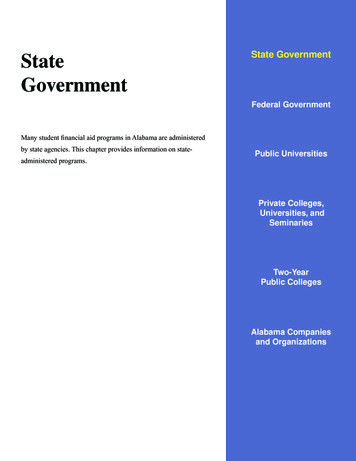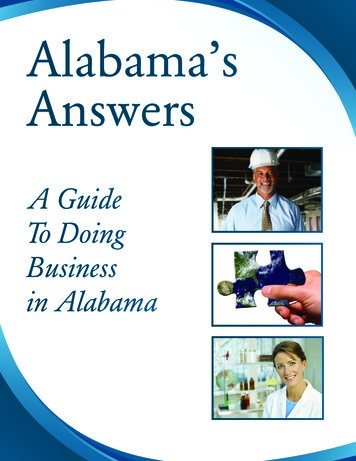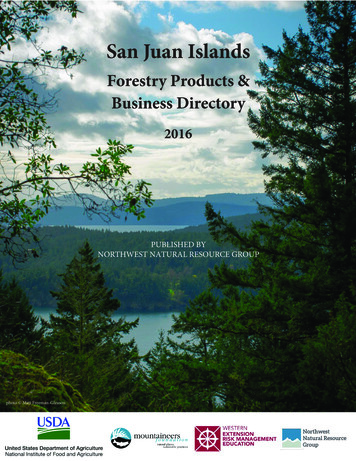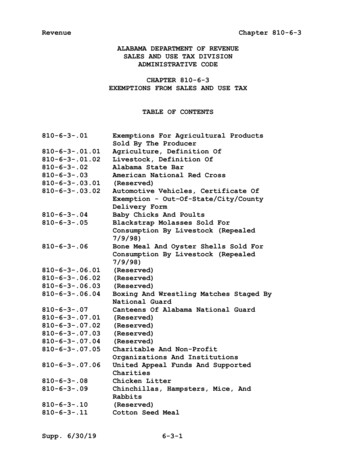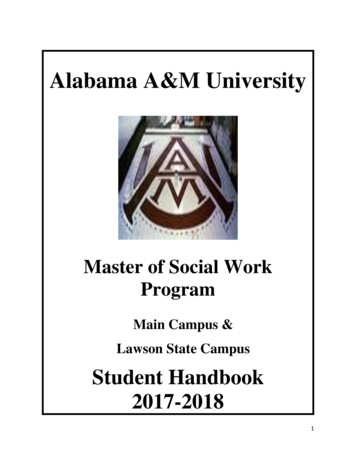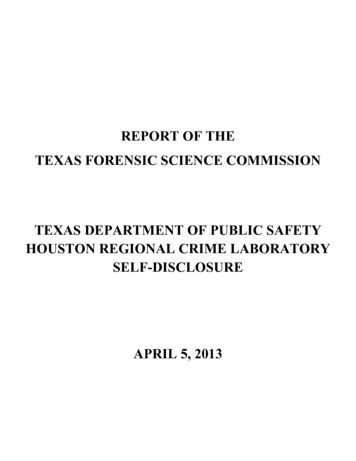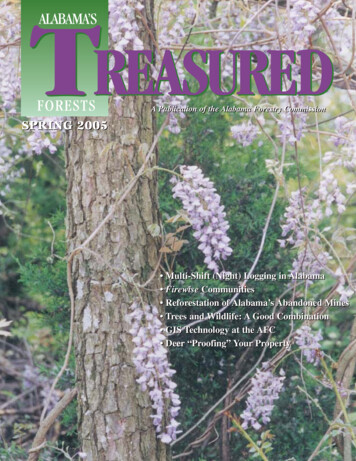
Transcription
ALABAMA’STREASUREDFORESTSA Publication of the Alabama Forestry CommissionSPRING 2005 Multi-Shift (Night) Logging in Alabama Firewise Communities Reforestation of Alabama’s Abandoned Mines Trees and Wildlife: A Good Combination GIS Technology at the AFC Deer “Proofing” Your Property
A MESSAGE FROM . . .Alabama is one of the most blessed states in our country with its natural beautyand abundant resources. Much of this beauty is located in one of our state’sfour national forests. The USDA Forest Service manages over 666,000 acresof land in Alabama that includes the Bankhead, Talladega, Conecuh, andTuskegee National Forests. These treasures are working forests that are managed formultiple uses like recreation, wildlife, timber, fish, water, soil, and wilderness.There is something for everyone in Alabama’s national forests. Hundreds of miles ofhiking, biking, horseback, and ATV trails run through this diverse land. Clean lakes andbeautiful streams provide opportunities for swimming, boating, canoeing, and fishing.Hunting is allowed in the wildlife-rich management areas and the forests give generousopportunities for bird watching, photography, picnicking, and camping. Mile after mileof rural roads provide sightseeing or just that quiet spot away from everything. Around41,000 acres of the national forests are kept as wilderness land where you can go andenjoy nature undisturbed.BOB RILEYThe stewards of this valuable resource are the men and women of the USDA ForestGovernor, State of AlabamaService. This year the agency is celebrating its centennial - 100 years of service to the landand the people that enjoy it. Alabama is most fortunate to have our national forests and the wonderful people who carefully manage itfor all of us to enjoy. The job they do is invaluable to our state and every citizen living here. Congratulations to the USDA ForestService on their 100th anniversary and keep up the good work of providing special places for each one of us.This year the USDA Forest Service is celebrating its 100th anniversary. In this100-year journey they have gone from an agency primarily responsible for protecting and conserving national forests and grasslands to one of the most valuable assets to state and private forestry in the nation.Aside from being the caretakers of 192 million acres that include 155 nationalforests, 20 national grasslands, and 222 research and experimental forests, the ForestService in the last century has become a vital and crucial part of the forest community atthe grass roots level. They provide leadership across the nation in wildland fire management, operations, research, and technology. Much of Alabama’s wildland firefightingprogram is dependent on the support of the Forest Service. It is only through their financial assistance that we are able to provide the fire protection that we do: through the purchase of equipment and gear, training of our firefighters, aerial detection, communications, fuel reduction, fire prevention, and education. Not only do they assist the AlabamaTIMOTHY C. BOYCEForestry Commission as an agency but they also have a large impact on rural volunteerState Foresterfire departments. Through the National Fire Plan and the Rural Community FireProtection Program, grant monies are administered by our agency for rural volunteerdepartments. These funds provide for the organization, training, and equipping of fire departments in our state’s rural communities.The Forest Service is behind many of our forest management programs such as southern pine beetle and stewardship forests.They provide research and technology in the area of forest health for such things as non-native invasive species as well as insectsand diseases. They support programs for water quality and clean air. Through us they help provide technical assistance and education to landowners and communities about how to care for their land. In addition, they are the leader in conservation educationefforts not only through their national forests programs, but because they have become important assets in their local schools andcommunities.In September Hurricane Ivan damaged and destroyed forestland and communities in much of south Alabama. It is through supplement emergency funds that the AFC has been able to reach out and provide assistance to landowners, communities, and firedepartments in the initial response and recovery efforts. This assistance will continue for several years because of the USDA ForestService.In the early 1900’s, Gifford Pinchot, the first Chief of the Forest Service, made a remark that has proved simple but true for 100years. He summed up the mission of the agency as, “to provide the greatest amount of good for the greatest amount of people in thelong run.” The USDA Forest Service has met and exceeded their mission. On behalf of the Alabama Forestry Commission I want tosay congratulations to the 37,000 employees of the Forest Service and I hope that you have many more years of service to ournation, state, and local communities.2 / Alabama’s TREASURED ForestsSpring 2005
CONTENTSVol. XXIV, No. 1Spring 2005GovernorBob RileyAlabama Forestry CommissionGary Fortenberry, ChairmanJerry Lacey, Vice ChairmanJohnny DennisTed DeVosJett FreemanDon HeathDavid LongState ForesterTimothy C. BoyceAssistant State ForesterRichard H. CumbieAdministrative Division DirectorJerry M. Dwyer47Firewise in the Wildland/Urban Interface andFirewise Communities/USA by Stanley Anderson14Alabama’s Reforestation of Abandoned Mine Landsby Walter E. Cartwright192122Trees and Wildlife - It’s a Good Combination by Julie A. Best27Keeping Your Yard and Garden Off the Menu: Ways to“Deer-Proof” Your Property by Coleen Vansant31Alabama Forestry Camp 2005 by James JenningsNorthwest RegionRegional ForesterWayne StrawbridgeAsst Regional Forester, Administration Bart WilliamsNortheast RegionRegional ForesterPhearthur MooreAsst Regional Forester, Administration Charles HallSoutheast RegionRegional ForesterAsst Regional Forester, Administration Dave DuckettSouthwest RegionRegional ForesterAsst Regional Forester, AdministrationEditorial BoardBruce SpringerDavid FrederickGary ColeOtis FrenchAlabama Forestry CommissionAlabama Forestry CommissionElishia Ballentine Johnson Alabama Forestry CommissionGus TownesAlabama Forestry CommissionDon StinsonAlabama TREASURE Forest Assoc.Coleen VansantAlabama Forestry CommissionEditorElishia BallentineJohnsonManaging EditorColeen VansantSpring 2005Logging Under the Night Sky: Multi-Shifting Comes to Alabamaby Tilda Mims11Fire Division DirectorDavid FrederickManagement Division DirectorBruce SpringerFull Circle by Elishia JohnsonThe Great Blue Heron - The Original Fishfinder by Rick ClaybrookOn the Cutting Edge of Technological Advancementby Dana McReynoldsDEPARTMENTS213Message from the Governor and the State Forester1826HIDDEN TREASURE: Touch of Country in the City by Tilda Mims32PLANTS OF ALABAMA: Wisteria by Coleen VansantHIDDEN TREASURE: Promoting Native Foods: An Economic andEffective Tool for Wildlife Management by Tilda MimsLEGISLATION AND POLICYLegislative Profile: Jack Biddle, III by Coleen VansantCover: Although a sign of Spring across the deep south and a familiar sight in the forests ofAlabama, did you know that the lovely wisteria is a non-native invasive species? Read aboutthis creeping beauty on the back cover.Photo by Coleen VansantBackground this page: Another springtime bloomer, the understated prettiness of floweringquince is fortunately not a favorite food of deer. Learn how to protect your lawn with otherplants that are deer-resistant on page 27.Photo by Coleen VansantAlabama’s TREASURED Forests (ISSN 0894-9654) is published quarterly by the Alabama ForestryCommission, 513 Madison Avenue, Montgomery, AL 36130. Telephone (334) 240-9355. Bulk rate postagepaid at Montgomery, Alabama. POSTMASTER: Send address changes to: Alabama’s TREASURED Forests,P.O. Box 302550, Montgomery, AL 36130-2550. Web site: www.forestry.state.al.usThe publication of a story or article in this magazine does not constitute the Alabama Forestry Commission'sendorsement of that particular practice, but is an effort to provide the landowners of Alabama with information and technical assistance to make informed decisions about the management practices they apply to theirland. The Alabama Forestry Commission is an equal opportunity employer and provider.Alabama’s TREASURED Forests / 3
Full Cir cleBy Elishia Johnson, EditorRetirement. The word is noteven in Raymond Newman’svocabulary. However, managing the land, making improvements, planting and enjoying watchingpine trees grow . . . those are phrasesyou’ll hear often if you talk to Mr.Newman for very long.Born and raised “just down the road,”he first bought the property in LeeCounty in the late 40s – 1,046 acresoriginally. It was not very well managed,mostly crop and pasture land. Now, somesixty-odd years later, the land is muchimproved and there are quite a few moreacres. It’s covered in pines and hardwoods, and wildlife thrives here.Mr. Newman began converting CircleN Farm to timber back in the late 70’s.He had originally farmed the land: cotton, corn, and vegetables. Next he had4 / Alabama’s TREASURED Foreststried his hand at the cattle business, alsohaving horses and raising Shetlandponies for a while. He laughingly sayshe was “kicked, hooked, thrown, evenchased by a Brahma bull.” Then, whenthe cattle market started declining, hesold every one of them – more than 400head. Growing pines just seemed to bethe obvious choice. He remarked that ina way, it was as if he were coming backfull circle to something he had alwaysloved. He started planting timber, andhasn’t regretted it one bit.There are a few slash and long leafpines, but the plantations are predominantly loblolly. The age of the pine treesat Circle N range from 1-year-oldseedlings to 40 to 50-year-old maturestands. Having been in the timber business for over 50 years, it’s not surprisingthat one of Mr. Newman’s managementSpring 2005
more than 40 acres of winter grazingplots of wheat, clover, and brown topmillet. But planting of these grains is justthe beginning . . . he has the equipmentto do the whole process: a combine cutsthe seed, then it is cleaned, bagged, andstored. Last year he harvested 70,000pounds of wheat.And don’t forget the fish. There arethree ponds at Circle N: a 17-acre, an 8acre, and a 4-acre. They harvest blue gill,shell cracker, copper nose bream, andlargemouth bass. In addition to fertiliz(Continued on page 6)Right: This road leading through astand of 30-year-old loblolliesrepresents just a portion of the 135miles of road that take RaymondNewman anywhere he wishesto go on his farm.Below: Hardwoods and maturepines enhance the view from thehunting lodge.Photos by Elishia JohnsonPhoto by Elishia JohnsonOver the years, they’ve received assistance and guidance from the AlabamaForestry Commission, as well as the Soiland Water Conservation folks.With all of the effort he puts into timber, which is his secondary TREASUREForest objective, you can just imaginethe love and time Mr. Newman devotesto his primary objective: Wildlife! He isan avid quail hunter, and each year raisesseveral hundred. With over 100 acresplanted in food plots, there is also anabundance of turkey, deer, and doves.There are over 50 acres of grain sorghumand bicolor lespedeza for the quail, andtheories is thinning. He states, “Itimproves the quality as well as thegrowth of the trees.” He prefers plantingto natural regeneration, adding that it’ssmarter and more economical in the longrun. He is also a firm believer in prescribed burning, another practice that hecompletes on an annual basis. He saysthey burn 700-800 acres nearly everyFebruary. It seems that he actuallyworked his land under the principals ofthe TREASURE Forest program prior tohearing about it, long before becoming aTREASURE Forest in 1980 (Certificate#115). Then in 2003, all the hard workand sound management paid off when hewas honored as a Helene MosleyMemorial Award Winner for theSoutheast Region.Although it is obvious that Mr.Newman himself is the “overseer,” hesays his son, Mike, also helps at thefarm. That is, when he’s not busy running the family timber business –Raymond turned that enterprise over tohis son a few years ago, so that he coulddevote all of his energies to the farm.Spring 2005Alabama’s TREASURED Forests / 5
Photo by Elishia JohnsonWildlife is the primary TREASUREForest objective of Circle N Farm.Over 100 acres planted in foodplots, such as this greenfield, attractan abundance of turkey, deer, anddoves.Photo by Elishia Johnsoning, liming, and setting turtle traps, Mr.Newman states they keep the bass happyby feeding the bream. He says that hemanages the ponds to promote good,quality fishing.One of the most notable features ofthis TREASURE Forest is the roadbuilding.According to Mr.Newman, thereare 135 miles ofroad, all of whichthey build andmaintain themselves. He saysthat there isnowhere on theproperty that hecan’t go and seewhat he wants to see! They quarrybronze rock out of three rockpits on the property, haul itwith a 25-ton dump truck,use a D6 Caterpillar to crushit, then shape it with a 130Gmotor grader.In all of his “spare” time,Mr. Newman attends to hishobby: the fruit orchards. Heraises plums, pears, scuppernong grapes, as well as eightor ten varieties of peachesincluding Georgia Belle, RedHaven, and Lohring. Heexplains that it gives himgreat satisfaction to share thefruits of his labor with neighbors andfriends. He also occasionally enjoysshooting at his regulation skeet range,and he’s been known to host friends atthe hunting lodge that he built about 30years ago.Meanwhile, Raymond Newman doesn’thave any plans to retire. He hasn’t gottime . . . he’s much too busy carrying outhis timber farming philosophy which hasproven quite successful: cut, spray, burn,then plant more!Photo by Elishia JohnsonPhoto by Elishia JohnsonBelow: An avid quail hunter, everyyear Mr. Newman raises severalhundred birds from chicks. He lovesto shoot birds and work with his fivebird dogs.Left: Raymond Newman,pictured with the skid steerthat he says makes a snapof clearing the forest floorof sweet gum saplings andother undergrowth.Right: The three ponds onthe property are not onlyaesthetically pleasing, butalso provide good fishingfor bass and bream.6 / Alabama’s TREASURED ForestsSpring 2005
Photo by Tilda MimsTruck drivers firmly attacha blinking yellow light tothe longest log of eachload as they continuetheir steady delivery tothe sawmill.Logging Underthe Night Sky:Multi-ShiftingComes to AlabamaBy Tilda Mims, AFC RetiredTimber harvesting in Alabama,like logging in any other area ofthe country, is about more thanjust harvesting the forest thesedays. It is also about new harvestingmethods, continuing education, soundenvironmental practices, and perhapsmost important, sustainable forestresource management.Add these concerns to cost controls,timely deliveries, and employee safetyand it’s easy to see some of the constantchallenges facing logging contractors.Responses to Timber Harvesting magazine’s nationwide 2004 LoggingBusiness Survey reported a “downsizedand leaner logging force reeling fromhigher operating costs and poor profitability.” More than 200 loggers fromAlabama and 38 other states respondedSpring 2005to the study; one in four indicated theirbusinesses lost money in 2003.On the positive side, respondents wereupbeat about their future in logging. Asignificant number indicated they plan tostay in business and pass it on to a son ordaughter. While many reported diversification and cost-cutting strategies as coping measures, others are looking to awhole new way of logging to not justsurvive, but succeed.Optimized logging, multi-shifting,double shifting, and night logging areterms to describe the practice of runninga logging crew around the clock. Thoughtypical in extremely cold climates wheredays are short and inclement weather isthe norm, logging under bright lights isvery new to Alabama.Johnny and Michelle Kynard ofGreensboro are good representatives ofthe new type of logging contractors whoare building their future on optimizedlogging. The Kynards are among the corecontractors for Gulf States PaperCorporation. In 2003, Gulf States beganexploring this new strategy in order tomaintain a consistent wood flow for theMoundville Sawmill. They expanded thedouble-shift concept by using the term“optimized logging” to include maximized equipment utilization.Rolfe Singleton, a harvest coordinatorfor Gulf States, was involved in the process from the start. “We offered theoption of trying optimized logging to allof our core contractors and Johnny wasimmediately interested.” They visitedseveral sites to get a first-hand view.(Continued on page 8)Alabama’s TREASURED Forests / 7
Photos by Tilda MimsSkidders are equipped withspecially-designed lighting packagesto increase illumination on all sides.equipment before each shift. Betweenshifts, crews discuss work progress andlayout, machine problems, and othershoptalk. This attention to preventivemaintenance keeps all equipment inexcellent condition.The harvesting operation centers onan on-site service truck. It is a wellequipped workshop and parts storagefacility with hoses, fuels, hydraulic hosemachine, welder, bolts bins, and manyspecialized tools. There are threemechanics in the crew and at least onemechanic available on each shift.When computerized equipment needsrepair however, they have to rely on specially-trained technicians. “We have agreat working relationship with WarriorTractor Company in Northport,” Johnnypoints out. “ I talked to them early in thisprocess to make sure we would have thebacking we needed to operate nights.We’ve had a mechanic down here at 2:30in the morning to work on the computerin a piece of equipment.” ReliablePhotos by Tilda MimsMost new multi-shift operations in theSouth are running a 24/7 business withhighly specialized cut-to-length equipment. Johnny says that when they cameback to Alabama, he knew they could doit with his current equipment.In late 2003, the Kynards started asecond shift for a trial period using twotrucks, one loader, and one skidder.According to Johnny, they tried cutting atnight but it wasn’t profitable or safeenough. So, they added a cutter to theday shift and concentrated on skidding,sorting, and loading during the secondshift. “When we first started the trialperiod, it affected everyone’s family lifebecause we were learning as we went,but we never gave up,” he says. “From afinancial point of view, I had to do something. We worked only 221 days in 2002due to weather and markets. I knew wehad to try something new in order tokeep the business going.”Optimized logging for the Kynardsofficially started January 1, 2004. FromJanuary 1 through July 2004, the crewsmissed only seven workdays.The full crewworks days,Monday throughFriday. Nine experienced employees– two skidderdrivers, two loaderoperators, and five truck drivers – worksecond shift Monday through Thursday.Johnny is there from “can to can’t”working with Gulf States and motivatingthe crew to maintain high production,quality, and safety.The goal is to work nine shifts a weekand be off on the weekend. If weather isa factor during the week, they may workweekends to make up lost time.Operating two shifts increasesdemands for maintenance and safetymeasures, and attention to detail becomesmore critical. Johnny contends maintenance is even better than before becausethere are three sets of eyes checking outequipment, two times a day. Both operators and the mechanic look over allOperating two shifts increasesdemands for maintenance. Bothoperators and the mechanic lookover all equipment before eachshift. This attention to preventivemaintenance keeps all equipment inexcellent condition.8 / Alabama’s TREASURED ForestsSpring 2005
(L to R) Rolf Singleton and JohnnyKinard work together almost daily toensure the productivity of the optimized logging operation.Photo by Tilda Mimsmechanic support is critical to their success. “They help us get back to work,” hesaid.The equipment shows only normalwear and tear for the number of hours theequipment is operating. It will wear outfaster, of course, but that isn’t a problembecause they are just as productive atnight as in the day.Safety is a concern on every loggingsite, but when visibility is limited, risksrequire more attention. Careful tractselection is the key. Rolfe says that notall tracts are suitable for optimized logging. “Steep terrain and old-growth timber requires people on the ground andthat is not safe at night.”Once the site is approved for optimized logging, a Gulf States crew marksproperty lines and streamside management zones, and determines needed BestManagement Practices. The day shiftcuts and skids timber around edges of thetract to clearly mark lines for the nightcrew. Boundary lines cut during the daylet the night crew know exactly where tobegin and end. Extra set-up work performed by the day shift allows the 4:00p.m. crew to continue the pace.As the sun begins to set, the rhythm ofthe machines halts briefly while the crewprepares for a night’s work under a starrysky. Poles of high-powered halogenbulbs are raised high, casting 8,000 wattsof additional light over the entire worksite. All personnel slide on reflectivevests and lighted hardhats, and skiddersflip on specially designed lighting packages. Lighted roadway signs begin toglow in warning to passing drivers.Truck drivers firmly attach a blinkingyellow light to the longest log of eachload as they continue their steady delivery to the sawmill. One substantialadvantage is quicker turn-around time atthe sawmill. Night deliveries virtuallyeliminate waiting time, which is often30-40 minutes during the day shift.Casual observers in pick-up trucksoften pull onto the side of the red dirtroad, watching in fascination as the crewquickly resumes a steady pace of skidding, sorting, and loading.Merchandising is the separation ofspecies and products for loading ontrucks. Lighting allows the experienced(Continued on page 10)Lighting allows the experienced night loader/operator to be as accurate as the day operator.Spring 2005Alabama’s TREASURED Forests / 9
night loader-operator to be as accurate asthe day operator.An unexpected benefit is the ability ofthe skidder operator to pick out thesmallest logs in his path. When workingat night, skidder operators have very fewdistractions, with less interference fromoutside factors. This allows them tobecome more focused on wood nearestthe skidder, bringing along every usablepiece.Safety Rule #1 is: No worker on theground when equipment is running.Time spent in machines minimizes exposure to on-ground hazards. So, when anempty truck pulls up, the loader operatorshuts down until he is certain of the driver’s location and they have a chance totalk. When a skidder operator has toleave his equipment, others halt until heis back on the machine. Good coordination and full communication between allemployees keeps everyone on their toes.Experienced, capable employees arecritical for the success of this newmethod of logging. Kynard says he hashad no trouble attracting and retaininggood employees. All crewmembers aretrained in Best Management Practicesand have attended Professional LoggingManager training. Experienced peoplecame on board knowing it was for thenight shift, he said. One big reason for itssuccess is that it gives crews quality timeat home with their families. They have asteady paycheck and their weekends arefree.Rolfe says the new process is providing a steady source of wood for the mill.Just a few years ago, he was juggling 1718 different contractors. Today, he works10 / Alabama’s TREASURED ForestsPhotos by Tilda MimsBelow: The day shift cuts and skids timberaround edges of the tract to clearly marklines for the night crew.with only two, and both are optimizing.“It takes a lot of commitment and dedication to be successful in this,” he said. “Ithas been a win-win situation for us.”Customer service is important in anybusiness. For the private landowner,Johnny sees several reasons why a timberseller might like the idea of an optimizedlogging operation on his or her property,and all result from reduced time spent onthe tract. A harvesting that might takethree weeks in the standard systemshould take no more than one-half thetime under normal conditions. This flexibility may offer landowners more freedom to plan timber harvests around nesting season, hunting parties, rainy season,and other special conditions to receivetop dollar for their timber investment.In addition, the seller can take fulladvantage of timber markets. If the market is good, the number of loads delivered at the better price could easily double.Johnny and Michelle are confidentthis is a positive change for employeemorale and the bottom line as well. “Wewill never go back,” Johnny says. “Forus to survive as contractors, we had to beflexible and try something new.Optimized logging has been a good fitfor us.”The double-shift approach to logginghas attracted a lot of attention in its brieflife in the South. It has been touted as away to cut costs, become more efficientand productive, and help the U.S. compete in a tough global market. Whilesome veteran loggers are reluctant tochange, several Alabama loggers arewatching the Kynards and others withoptimism.Resources:Southern Loggin’ Times,June 2004Logging and Sawmilling Journal,December 2003 and January 2004Timber Harvesting,May/June 2004Spring 2005Photo by Stanley AndersonLeft: Three cutters work the day shift toensure sufficient logs for the night crew.
Firewise in theWildland/Urban InterfaceandFirewiseCommunities/USABy Stanley R. Anderson, Fire Division,Alabama Forestry Commission“Will Divide” – large tract of land in Baldwin County once owned by a major paper company.Healthwise, travelwise, moneywise and Firewise? Simplystated, Firewise is fire prevention. To a homeowner it meanspreventing fire by making the inside andoutside of the home safe from fire hazards or identifying and minimizing hazardous situations which may cause structural fire. To a forest landowner/homeowner, Firewise means all of this, plusoutside and beyond. To a homeowner inthe wildland/urban interface (WUI),Firewise means making the home safefrom wildland fire. In any case, Firewiselooks at ways to prevent fires where possible and mitigate or lessen the hazardsassociated with fire spread and intensity,should a fire occur. The goal of Firewiseis to prepare homes to withstand a wildland fire without the intervention of firefighters.Wildland/Urban Interface (WUI)The term wildland/urban interfacedescribes the “meeting” of different landuses. For instance, natural or managedforestland or rangeland may join developed urban or suburban areas. This interface might be a wildland area meeting acommunity or subdivision, or an industrial area joining wildlands.Wildfire has always been a natural partof many of the areas where we live. Infact, long before Europeans settled here,many forests were burned as a result oflightning and indigenous wildfires. Asareas populate in modern times, accidental fire from escaped control burns anddebris fires becomes more prevalent. Anddon’t forget arson, our single biggestSpring 2005cause of wildfire. As more and more people choose to live in the wildland/urbaninterface, it is important to make surethey understand the nature of their surroundings, including the dangers and patterns of wildfire.There are many homes and communities being built without regard to thewildfire history or fuel conditions in andaround the forest. Dense population inthese areas increases the chance of wildfire. Therefore, great potential exists forloss of life, property, and ecological values due to fuel conditions located in thewildland/urban interface.Forest FragmentationDuring the past ten years, forest ownership has experienced the biggest changesince the late 1940s to early 1950s whenthe pulp and paper companies began buying large tracts of land to support theirmills. There have been drastic changes inthe corporate climate of the pulp andpaper industry. Many large mills haveclosed; acquisitions, mergers, and leveraged buy-outs were almost daily newsduring the turn of the new century.Expensive mill modernization in order tomeet environmental and production goalshave influenced mill closure in somecompanies. Many companies have movedtheir resource and production assets toforeign countries with cheaper labor andenvironmental costs. As a result, severallarge companies sold their mill’s landbase.Enter fragmentation – subdivision –development. Suddenly, the wildland/urban interface broadens. Large tracts oftimberland that were once managed (undeveloped but periodically thinned, harvested, prescribe burned, and protectedfrom the spread of insects and disease)are now being divided and developed. Forexample, a 640-acre section of land thatonce had a single landowner with onemanagement philosophy might now havetwenty or more owners. Forest firefighters and firemen are now finding newchallenges in dealing with 20 acres and ahouse, 10 acres and a house, 1 acre and ahouse, as well as associated roads, driveways, low weight limit bridges, cul-desacs, structures, utility lines, and fences.Enter Firewise.Auburn University’s Center for ForestSustainability, in cooperation with theUSDA Forest Service and the NationalScience Foundation, led a conference inAtlanta to explore the challenges andopportunities created by wildland/urbaninterfaces. Various sorts of issues of interest were presented to a wide spectrum ofindividuals, especially those charged withurban planning and others dealing withaspects of urban sprawl.Firewise Communities/USAThe Firewise Communities/USARecognition Program enables communities in all parts of the U.S. to achieve ahigh level of protection against wildland/urban int
The Forest Service is behind many of our forest management programs such as southern pine beetle and stewardship forests. They provide research and technology in the area of forest health for such things as non-native invasive species as well as insects and disease
